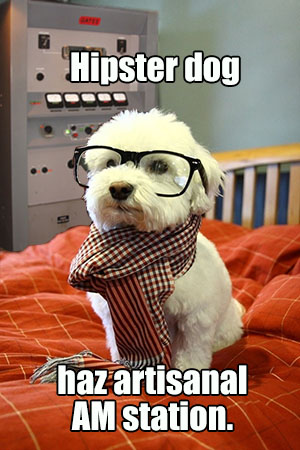 This week is the annual National Association of Broadcasters show in Las Vegas, which brings thousands of broadcasters, manufacturers, producers and journalists together to talk about and see what’s next for broadcasting. Radio tends to play a very quiet second fiddle to television and video at this show. But this year radio’s own second fiddle, the AM band, received some attention with a panel moderated by FCC Commissioner Ajit Pai.
This week is the annual National Association of Broadcasters show in Las Vegas, which brings thousands of broadcasters, manufacturers, producers and journalists together to talk about and see what’s next for broadcasting. Radio tends to play a very quiet second fiddle to television and video at this show. But this year radio’s own second fiddle, the AM band, received some attention with a panel moderated by FCC Commissioner Ajit Pai.
This panel was inspired by remarks made at last fall’s NAB Radio Show where Pai called for a revitalization of the AM band. Radio World’s Leslie Stimson reported on Tuesday’s panel, where CBS Radio’s Senior VP of Engineering Glynn Walden called for “an analog sunset” and a move to all-digital broadcasting. The sentiment comes from the fact that the band is plagued with interference from all sorts of electronics, as well as inter-station interference from night-time skywave propagation, when AM broadcasts can travel hundreds of miles.
Going all-digital was just one of four possible solutions Pai raised in his opening remarks. He also mentioned letting stations increase power, making it easier for AM broadcasters to obtain translator repeaters on the FM dial and transitioning to a distributed broadcast method called “synchronous transmission systems.” According to Stimson’s report, the FM translator idea was the most popular of these three amongst the panelists, while the power increase was largely dismissed.
In anticipation of this panel Variety’s TV columnist Brian Lowry dismisses the AM band altogether, calling it a “cesspool.” Unlike the NAB panelists Lowry is evaluating the actual content of AM broadcasts, not the technical integrity of the band itself. Lowry points a finger at talk radio–an easy target–but also the “insidious… relationship between stations and advertisers,” where hosts hawk gold, hair restoration and diet aids in the middle of their patter about politics and sports. He is even more critical of the “poorly labeled infomercials that fill stations primarily on weekend mornings, often for questionable medical supplements or cures.”
While I agree with much of Lowry’s critique, I’m not sure it’s fair to tar an entire broadcast band with the same feather, even if it’s a big ass feather. I still see value in the AM band. I’m not convinced about going all digital, but I’m also not sure what the right solution is.
Living in a big city with a crowded dial full of electromagnetic pollution, I certainly agree that listening to AM is not nearly as much fun as it was 10 or 15 years ago, unless you’re tuning in the most powerful local stations. The long-wave propagation of AM was always one of its selling points. Traveling down a lonely interstate late at night, it is still a real pleasure to tune in an AM blowtorch and hang onto that signal for hundreds of miles without having to hit the seek button. Yet, that experience is getting rarer, as interference intrudes even in sparsely populated areas.
I wonder if my and others’ attachment to AM is driven more by nostalgia than practicality. No doubt, broadcasters’ attachment is financial; they don’t want to give up on their investments. But offered the opportunity to listen to the same program on AM or FM, I’d probably choose FM for the fidelity and low noise.
One could make an aesthetic argument in defense of AM’s unique sonic signature, just as some folks (like me) still listen to cassette tapes. It’s just hard to see (or hear) how this is motivated by anything but nostalgia.
Going all digital might solve the noise problem and mitigate some of the interference issues, but is it a solution that anyone wants? It would require additional investment from broadcasters and force listeners to buy new radios. And for what? The same Limbaugh, Hannity and infomercials, just with less electromagnetic static?
Maybe AM doesn’t need revitalizing. Are die-hard AM listeners that unhappy? In my home city of Chicago the #2 and #4 highest rated stations are AM. In New York City the #4 and #9 stations are AM, and in Los Angeles AM stations rank #4 and #10. That’s a lot of listeners still tuning in, even if fewer than FM.
Why don’t we just let AM be and let the broadcasters and listeners decide when they’re done with it? That would be the cheapest option by far.
Then, when some stalwart broadcasters give up their AM licenses at firesale prices because they’re unprofitable, there could be an opportunity for a little retro-inspired, back to basics innovation. AM radio could become the broadcast version of artisanal Brooklyn pickles, sponsored by Vice Magazine infomercials.
Or maybe the erosion of station will relieve some of the crowding on the dial, mitigating the interference by attrition. Either way, nobody needs to buy new transmitters and radios, or waste any more precious FCC resources.
I vote artisanal AM.


